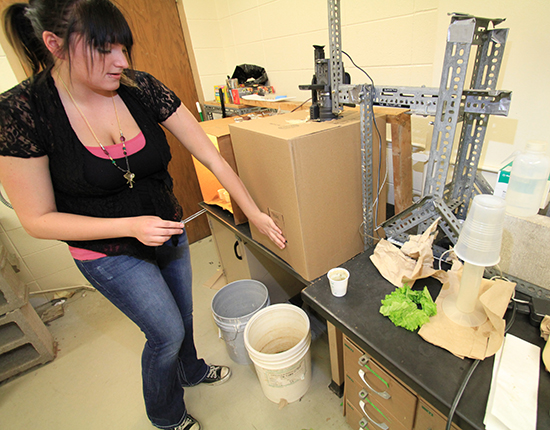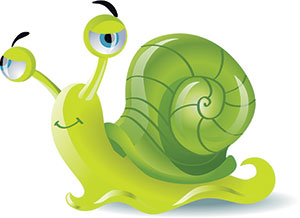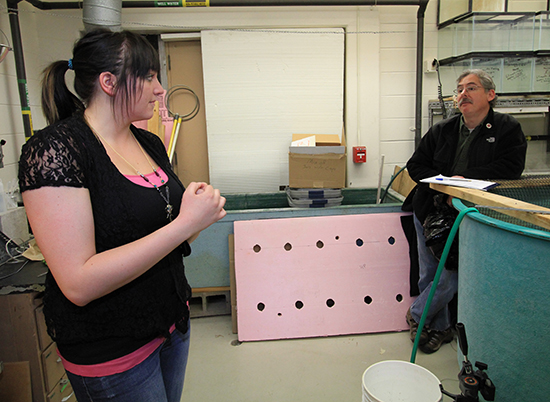Posted 2:48 p.m. Thursday, June 6, 2013

UW-L student researcher Krista Hines discovered an unexpected side of snails. Her research could help researchers better understand how some snails have killed thousands of waterfowl annually on the Mississippi River.
 UW-L biology major Krista Hines prepares her lab for monitoring snails.[/caption]
UW-L biology major Krista Hines prepares her lab for monitoring snails.[/caption]
Research aims to understand how these creatures threaten life on the Mississippi
UW-L biology major Krista Hines wants to become a marine biologist and study the behavioral patterns of sharks. So the UW-L senior was a bit disenchanted to learn she would get her feet wet studying something seemingly less exciting — snails. “I was like snails? Uhh, you just don’t think of them as being active,” recalls Hines. But she admits after several months of research, she’s seen a completely different side of her spiral-shelled friends. The creatures she once thought were stationary and dull, actually move around a lot — and their movement could help researchers better understand how some snails have successfully killed thousands of waterfowl annually in the Mississippi River. Hines studies invasive snails commonly found in the Mississippi River, faucet snails, and the parasites that live inside of them. UW-L scientists think that parasites might alter the behavior of this snail, making the parasites more likely to be eaten by waterfowl, which serve as their hosts. Parasites have so far killed more than 60,000 waterfowl in the region since the snail's arrival in the Mississippi River in the late 1990s. “It’s sad that many people don’t even know about this problem,” says Hines. “For me it’s really cool to be working on it. It’s work that means something.” Her research entails hours of observation, but lucky for Hines, she has high technology equipment to help her do it. She places the tiny black snails in a tub of water and records their movement over the course of several hours using a camera mounted above.
Half her snails are infected with a parasite and the other half are a control group with no parasite. After recording, she tracks the movement using computer image analysis technology — the same technology is used widely by the scientific and medical community to track changes such as cancer growth. Though results aren’t tabulated yet, she anticipates a difference between the groups — particularly in how much faster and more erratically the parasite-infected snails move.
Hines and her faculty research adviser Roger Haro hypothesize this would be a good evolutionary tactic of the parasite. A snail that moves more is potentially more tempting prey to a duck or other waterfowl, which ultimately becomes the parasite’s host.
The research started after the U.S. Fish and Wildlife Service and US Geological Survey approached UW-L’s River Studies Center to see if they could help find additional information on the invasive snail. Biology faculty members Greg Sandland, Roger Haro and two math faculty members, James Peirce and Barbara Bennie, secured a three-year, $236,822 National Science Foundation (NSF) Interdisciplinary Training for Undergraduates in Biological and Mathematical Sciences (UBM) Grant to organize math and biology students to work together on invasive snail research.
“This allows students to learn the power of collaboration and interdisciplinary studies early on,” explains Haro.
[caption id="attachment_23825" align="alignnone" width="462"]
Her research entails hours of observation, but lucky for Hines, she has high technology equipment to help her do it. She places the tiny black snails in a tub of water and records their movement over the course of several hours using a camera mounted above.
Half her snails are infected with a parasite and the other half are a control group with no parasite. After recording, she tracks the movement using computer image analysis technology — the same technology is used widely by the scientific and medical community to track changes such as cancer growth. Though results aren’t tabulated yet, she anticipates a difference between the groups — particularly in how much faster and more erratically the parasite-infected snails move.
Hines and her faculty research adviser Roger Haro hypothesize this would be a good evolutionary tactic of the parasite. A snail that moves more is potentially more tempting prey to a duck or other waterfowl, which ultimately becomes the parasite’s host.
The research started after the U.S. Fish and Wildlife Service and US Geological Survey approached UW-L’s River Studies Center to see if they could help find additional information on the invasive snail. Biology faculty members Greg Sandland, Roger Haro and two math faculty members, James Peirce and Barbara Bennie, secured a three-year, $236,822 National Science Foundation (NSF) Interdisciplinary Training for Undergraduates in Biological and Mathematical Sciences (UBM) Grant to organize math and biology students to work together on invasive snail research.
“This allows students to learn the power of collaboration and interdisciplinary studies early on,” explains Haro.
[caption id="attachment_23825" align="alignnone" width="462"] UW-L student researcher Krista Hines discusses her study with faculty adviser Roger Haro.[/caption]
Other UW-L studies related to invasive snails include one featured on the prestigious website Environmental Progress. The study documents a series of laboratory experiments that assess the tolerances of faucet snails and native snails to drying out at two separate stages of life. The study was published by Haro, Sandland and two students, Allison Wood and Cody Haro.
Studying the snail’s behavior helps scientists and conservationists understand an invasive species that is threatening life on the Mississippi. Hines’ research could help scientists better understand the conditions the parasite-infected snails favor, which could help prevent their consumption by prey and thus waterfowl death. In particular, Haro says the research could potentially aid the U.S. Army Corps of Engineers and the Fish and Wildlife Service in creating islands on the Mississippi.
“We don’t want them to stop creating habitat, but maybe we can help them alter the design so islands are less likely to harbor these nasty snails,” says Haro.
UW-L student researcher Krista Hines discusses her study with faculty adviser Roger Haro.[/caption]
Other UW-L studies related to invasive snails include one featured on the prestigious website Environmental Progress. The study documents a series of laboratory experiments that assess the tolerances of faucet snails and native snails to drying out at two separate stages of life. The study was published by Haro, Sandland and two students, Allison Wood and Cody Haro.
Studying the snail’s behavior helps scientists and conservationists understand an invasive species that is threatening life on the Mississippi. Hines’ research could help scientists better understand the conditions the parasite-infected snails favor, which could help prevent their consumption by prey and thus waterfowl death. In particular, Haro says the research could potentially aid the U.S. Army Corps of Engineers and the Fish and Wildlife Service in creating islands on the Mississippi.
“We don’t want them to stop creating habitat, but maybe we can help them alter the design so islands are less likely to harbor these nasty snails,” says Haro.
